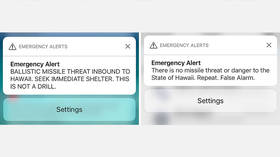Not a drill: Hawaii missile false alarm caused surge in anxiety with lasting effects, report says

A false alarm ‘incoming missile’ alert sent to people in Hawaii in January 2018 had a lasting effect on anxiety levels, a new study has shown. People who were less anxious beforehand were most affected by the incident.
“Ballistic missile threat inbound to Hawaii,” the erroneous text message said. “Seek immediate shelter. This is not a drill.” It took 38 minutes before a second text was sent out confirming the first alert was a false alarm.
An analysis of Twitter activity before and after the event reveal insights into the anxiety levels felt by the people in Hawaii at the time of and after the event.
Also on rt.com US seeks to install $1bn radar in Hawaii to detect ballistic missiles“Our results suggest that the experience may have a lingering impact on some individuals well after the threat is dispelled,” said psychologist Nickolas Jones from the University of California, Irvine (UCI).
Researchers examined over 1 million tweets from 15,000 Twitter users who they determined were likely in Hawaii at the time of the false alarm. They looked at the language used in their tweets sent from six weeks before the incident to 18 days after it. The team had a list of 114 keywords associated with expressions of anxiety, like ‘afraid’ and ‘worried’.
As you’d expect, anxiety levels increased during the event, rising by 3.4 percent every 15 minutes until the all-clear was given. Researchers were surprised, though, to see that the anxiety persisted after the false alarm message was spread.
Also on rt.com Tension relief? Hawaiians rush to Pornhub minutes after false ballistic missile alarm“This suggests that cancellation of a threat doesn’t immediately calm reactions to the situation. Amazingly, some people did not know whether the corrective tweets were believable,” said one of the researchers, Roxane Cohen Silver.
The event had a different impact on users depending on how anxious they were before the false alarm, with those who had been identified as having low anxiety levels appearing to be more affected after the event, as their “anxiety increased the most and lingered the longest, relative to other groups, before stabilizing to a new baseline level 2.5 percent higher than what it was before the missile alert,” the paper reads.
Those who were identified as being anxious before the event were shown to be 10.5 percent less anxious afterwards. It isn’t clear why this was the case, but researchers suggest it may be that these people may have recognized how much worse things could have been and experienced relief.
Like this story? Share it with a friend!














